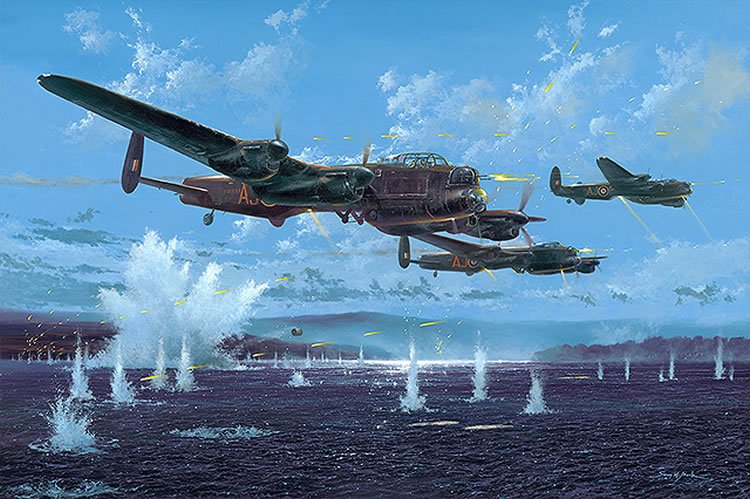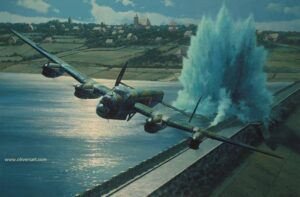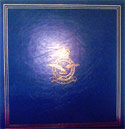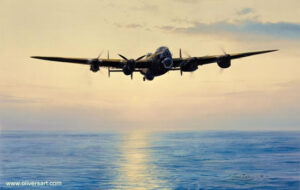Description
The moment Sqn. Ldr. HM “Dinghy” Young attacks the Mohne Dam, flying Avro Lancaster ED877, AJ-A (Apple) in the early morning of May 17th 1943.
Flanked by aircraft flown by Wg. Cdr. Guy Gibson to starboard and Flt. Lt. Harold “Mickey” Martin to port, the three 617 Squadron Lancasters charge down the Mohnesee Reservoir against a hail of German flak from batteries on the dam and from mobile units in the surrounding fields. The three RAF front turret gunners train return fire on the German flak positions ahead, as Dinghy’s bomb aimer launches A-Apple’s upkeep mine….
Sqn. Ldr. Henry Melvin Young DFC and Bar was born in London on 20th May 1915. He was educated in America and England and at Trinity College Oxford, gaining a rowing blue as a member of the winning Boat Race Crew of 1938. That same year he graduated and joined the Royal Air Force Volunteer Reserve and became a bomber pilot, serving from the start of the war with 102 and 104 Squadrons. He acquired the nickname “Dinghy” after being shot down twice over the sea and surviving the ordeals in the aircrafts’ inflatable life rafts.
He was a courageous and very capable bomber captain. In early 1943, he drew the attentions of Wg. Cdr. Guy Gibson who selected him for the newly forming 617 Squadron and its highly secretive operational debut, as his overall 2nd In Command of the Squadron.
On the day of Operation Chastise 16th May, arriving with his crew at his Lancaster’s hardstand at RAF Scampton, he turned, smiling to his WAAF MT driver and kissed her on the cheek saying,
“So long old girl. I won’t be paddling home from this one…”
Dinghy’s attack was the fourth and the penultimate attack on the Mohne Dam. Gibson had made the first and had failed to effect a breach. Flt. Lt. John Hopgood and four of his crew had been shot down and killed attempting the second strike, which had successfully destroyed the Mohnesee Power station nestling in the lee of the dam’s massive curtain. Flt. Lt. Mickey Martin’s attack saw his mine veer off to the left on its bouncing run, hitting the left approach tower but putting the flak battery atop of it out of action with the incredible column of exploding water falling back onto it. But it had done nothing to dampen the intensive concentration of flak from the right tower and the surrounding fields.
As the water calmed from Mickey Martin’s attack Gibson ordered him to take station on Dinghy’s port wing, while he would cover his 2nd In Command’s attack with fire from the starboard flank. The three Lancasters formated over the spit of headland that marked the approach to the target and descended together, closing-up, like cavalry in the charge.
Under relentless enemy fire, they thundered over the moonlit water with the front turret gunners returning fire ahead of them. Dinghy settled his Lancaster perfectly level at 60ft and his bomb aimer Fg. Off. Vincent MacCausland made a clean and accurate launch of the Upkeep mine, hitting the wall, precisely as Dr. Barnes Wallis had required at the previous day’s briefing.
As Dinghy’s rear gunner Sgt Wilfred Ibbotson, observed the dam lit by the fire of the power station pass away into the distance below him, he saw a massive column of water cascading for a thousand feet into the moonlit air. The granite beneath the German soldiers’ boots slightly but perceptibly trembled. Water began to pour from fissures in the curtain wall. But it seemed the massive structure was holding up. Then, slowly, certainly, it began to crumble at its upperworks and the escaping water began to gather force….
When Flt Lt David Maltby made his attack that would see the ultimate collapse of the dam, he saw the crest falling away as he cleared his Lancaster over it. His weapon had added its massive, explosive weight to the destruction already inflicted by Dinghy’s accurate strike. The destruction of the Mohne Dam was complete. A huge breach across a wide area unleashed a biblical torrent of water flooding into the open country for mile after mile with devastating, destructive force.
After viewing the destruction of the dam, Gibson ordered Martin to set course for home while he led the rest of his wing with Young as his deputy, for the attack on the Eder dam.
It was on the homeward approach to the sea on the Dutch coast that ‘Dinghy’ and his crew met their fate. It seems that he may have climbed higher to an altitude where German Radar had intercepted him and the German Flak positions along his route were alerted ready for any aircraft that came their way. He was shot down into the sea possibly by an anti aircraft unit at Castricum-aan-zee on the Dutch coast. As Dinghy had told his WAAF driver, prophetically, there was to be no lucky escape by rubber dinghy this time.
The bodies of Sqn. Ldr. Henry Melvin Young and his crew of ED877, A-Apple, were washed ashore over several days and were buried in the General Cemetery at Bergen, Holland.
All orders are supplied with the back story behind the painting.
Giclée Print on Archival Paper
Measuring 33″ x 24″ and printed on very high quality Archival Paper. Signed and numbered by Simon Atack and issued with a Certificate of Authenticity
Giclée Print on Canvas – UK orders only
For that ‘original’ look. 36″ x 24″ supplied unstretched and signed and numbered on the back of the canvas and issued with a Certificate of Authenticity
Remarque Edition
Giclée Print on Archival Paper – Measuring 33″ x 24″ and printed on very high quality Archival Paper. Signed and numbered by Simon Atack and issued with a Certificate of Authenticity. Simon will draw a small original pencil image at the bottom of the print on either the left, right or in the middle
Double Remarque Edition
Giclée Print on Archival Paper – Measuring 33″ x 24″ and printed on very high quality Archival Paper. Signed and numbered by Simon Atack and issued with a Certificate of Authenticity. Simon will draw a double original pencil image at the bottom of the print (eg. two aeroplanes)
Edition Sizes:
Giclée Print on Archival Paper – 400
Giclée Print on Canvas – 200
Remarque Edition – 50
Copyright Image and Text Simon W. Atack




